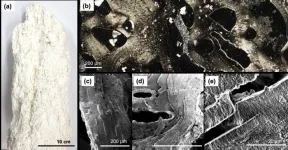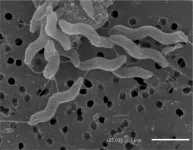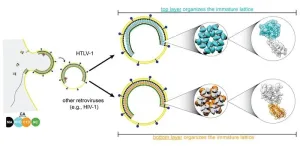(Press-News.org) There are more than 7,000 rare and undiagnosed diseases globally.
Although each condition occurs in a small number of individuals, collectively these diseases exert a staggering human and economic toll because they affect some 300 million people worldwide.
Yet, with a mere 5 to 7 percent of these conditions having an FDA-approved drug, they remain largely untreated or undertreated.
Developing new medicines represents a daunting challenge, but a new artificial intelligence tool can propel the discovery of new therapies from existing medicines, offering hope for patients with rare and neglected conditions and for the clinicians who treat them.
The AI model, called TxGNN, is the first one developed specifically to identify drug candidates for rare diseases and conditions with no treatments.
It identified drug candidates from existing medicines for more than 17,000 diseases, many of them without any existing treatments. This represents the largest number of diseases that any single AI model can handle to date. The researchers note that the model could be applied to even more diseases beyond the 17,000 it worked on in the initial experiments.
The work, described Sept. 25 in Nature Medicine, was led by scientists at Harvard Medical School. The researchers have made the tool available for free and want to encourage clinician-scientists to use it in their search for new therapies, especially for conditions with no or with limited treatment options.
“With this tool we aim to identify new therapies across the disease spectrum but when it comes to rare, ultrarare, and neglected conditions, we foresee this model could help close, or at least narrow, a gap that creates serious health disparities,” said lead researcher Marinka Zitnik, assistant professor of biomedical informatics in the Blavatnik Institute at HMS.
“This is precisely where we see the promise of AI in reducing the global disease burden, in finding new uses for existing drugs, which is also a faster and more cost-effective way to develop therapies than designing new drugs from scratch,” added Zitnik, who is an associate faculty member at the Kempner Institute for the Study of Natural and Artificial Intelligence at Harvard University.
The new tool has two central features — one that identifies treatment candidates along with possible side effects and another one that explains the rationale for the decision.
In total, the tool identified drug candidates from nearly 8,000 medicines (both FDA-approved medicines and experimental ones now in clinical trials) for 17,080 diseases, including conditions with no available treatments. It also predicted which drugs would have side effects and contraindications for specific conditions — something that the current drug discovery approach identifies mostly by trial and error during early clinical trials focused on safety.
Compared against the leading AI models for drug repurposing, the new tool was nearly 50 percent better, on average, at identifying drug candidates. It was also 35 percent more accurate in predicting what drugs would have contraindications.
Advantages of using already approved drugs
Repurposing existing drugs is an alluring way to develop new treatments because it relies on medicines that have been studied, have well-understood safety profiles, and have gone through the regulatory approval process.
Most medicines have multiple effects beyond the specific targets they were originally developed and approved for. But many of these effects remain undiscovered and understudied during initial testing, clinical trials, and review, only emerging after years of use by millions of people. Indeed, nearly 30 percent of FDA- approved drugs have acquired at least one additional indication for treatment following initial approval, and many have acquired tens of additional treatment indications over the years.
This approach to drug repurposing is haphazard at best. It relies on patient reports of unexpected beneficial side effects or on physicians’ intuition about whether to use a drug for a condition that it was not intended for, a practice known as off-label use.
“We’ve tended to rely on luck and serendipity rather than on strategy, which limits drug discovery to diseases for which drugs already exist,” Zitnik said.
The benefits of drug repurposing extend beyond diseases without treatments, Zitnik noted.
“Even for more common diseases with approved treatments, new drugs could offer alternatives with fewer side effects or replace drugs that are ineffective for certain patients,” she said.
What makes the new AI tool better than existing models
Most current AI models used for drug discovery are trained on a single disease or a handful of conditions. Rather than focusing on specific diseases, the new tool was trained in a manner that enables it to use existing data to make new predictions. It does so by identifying shared features across multiple diseases, such as shared genomic aberrations.
For example, the AI model pinpoints shared disease mechanisms based on common genomic underpinnings, which allows it to extrapolate from a well-understood disease with known treatments to a poorly understood one with no treatments.
This capacity, the research team said, brings the AI tool closer to the type of a reasoning a human clinician might use to generate novel ideas if they had access to all the preexisting knowledge and raw data that the AI model does but that the human brain cannot possibly access or store.
The tool was trained on vast amounts of data, including DNA information, cell signaling, levels of gene activity, clinical notes, and more. The researchers tested and refined the model by asking it to perform various tasks. Finally, the tool’s performance was validated on 1.2 million patient records and asked to identify drug candidates for various diseases.
The researchers also asked the tool to predict what patient characteristics would render the identified drug candidates contraindicated for certain patient populations.
Another task involved asking the tool to identify existing small molecules that might effectively block the activity of certain proteins implicated in disease-causing pathways and processes.
In a test designed to gauge the model’s ability to reason as a human clinician might, the researchers prompted the model to find drugs for three rare conditions it had not seen as part of its training — a neurodevelopmental disorder, a connective-tissue disease, and a rare genetic condition that causes water imbalance.
The researchers then compared the model’s recommendations for drug therapy against current medical knowledge about how the suggested drugs work. In every example, the tool’s recommendations aligned with current medical knowledge.
Moreover, the model not only identified medicines for all three diseases but also provided the rationale behind its decision. This explainer feature allows for transparency and can increase physician confidence.
The researchers caution that any therapies identified by the model would require additional evaluation for dosing and timing of delivery. But, they add, with this unprecedented capacity, the new AI model would expedite drug repurposing in a manner not possible until now. The team is already collaborating with several rare disease foundations to help identify possible treatments.
Authorship, funding, disclosures
Co-authors included Kexin Huang, Payal Chandak, Qianwen Wang, Shreyas Havaldar, Akhil Vaid, Jure Leskovec, Girish N. Nadkarni, Benjamin S. Glicksberg, and Nils Gehlenborg.
This work was supported by National Science Foundation CAREER award (grant 2339524), National Institutes of Health (grant R01-HD108794), U.S. Department of Defense (grant FA8702-15-D-0001), Amazon Faculty Research, Google Research Scholar Program, AstraZeneca Research, Roche Alliance with Distinguished Scientists, Sanofi iDEA-TECH Award, Pfizer Research, Chan Zuckerberg Initiative, John and Virginia Kaneb Fellowship at HMS, Biswas Family Foundation Transformative Computational Biology Grant in partnership with the Milken Institute, HMS Dean’s Innovation Awards for the Use of Artificial Intelligence, Kempner Institute for the Study of Natural and Artificial Intelligence at Harvard University, and Dr. Susanne E. Churchill Summer Institute in Biomedical Informatics at HMS.
END
Researchers harness AI to repurpose existing drugs for treatment of rare diseases
New AI model identifies drug candidates for thousands of rare diseases without current therapies
2024-09-25
ELSE PRESS RELEASES FROM THIS DATE:
Combination treatment improves response to immunotherapy for lung cancer
2024-09-25
Francis Crick Institute press release
Under strict embargo: 10:00hrs BST Wednesday 25 September 2024
Peer reviewed
Experimental study
Animals
Combination treatment improves response to immunotherapy for lung cancer
Researchers at the Francis Crick Institute, in collaboration with Revolution Medicines, have tested a combination of treatments in mice with lung cancer and shown that these allow immunotherapies to target non-responsive tumours.
Their findings show that targeting tumours in ...
Nanostructures in the deep ocean floor hint at life’s origin
2024-09-25
Researchers led by Ryuhei Nakamura at the RIKEN Center for Sustainable Resource Science (CSRS) in Japan and The Earth-Life Science Institute (ELSI) of Tokyo Institute of Technology have discovered inorganic nanostructures surrounding deep-ocean hydrothermal vents that are strikingly similar to molecules that make life as we know it possible. These nanostructures are self-organized and act as selective ion channels, which create energy that can be harnessed in the form of electricity. Published Sep. 25 in Nature Communications, the findings impact not only our understanding of how life began, but can also ...
Humbug damselfish use 'motion dazzle' to evade predators
2024-09-25
When thinking of animal camouflage, we typically imagine creatures remaining still, blending seamlessly into their surroundings. But remaining motionless isn’t always practical, and many animals are highly mobile, constantly moving through their environment to graze their food.
New research suggests that high-contrast patterns on animals’ bodies may serve a dual purpose: offering camouflage when stationary, then creating a ‘motion dazzle’ effect when moving, confusing potential predators into misjudging their location – and helping them avoid being ...
Can a drug-free nasal spray protect against deadly respiratory infections?
2024-09-25
New research published in Advanced Materials reports a novel nasal spray for preventing respiratory infections. The spray works by forming a protective coating on the nasal cavity, which captures airborne respiratory droplets and acts as a physical barrier against viruses and bacteria, while effectively neutralizing them.
In studies conducted on mice, the Pathogen Capture and Neutralizing Spray (PCANS) demonstrated up to 8 hours of nasal retention. In a severe Influenza A model, a single pre-exposure dose of PCANS resulted in a greater than 99.99% reduction ...
Do natural disasters jeopardize women’s reproductive health?
2024-09-25
In research published in Brain and Behavior, investigators found increased rates of menstrual irregularities in women living in areas affected by the 2023 earthquake in Turkey.
In the study, 309 women of reproductive age living in regions declared as disaster areas completed online forms 9 months after the earthquake. Responses revealed an increase of menstrual irregularities from 14.3% before the earthquake to 44.8% after the earthquake. Risk factors for menstrual irregularities included post-traumatic stress symptoms, chronic diseases, and smoking.
The findings reveal that reproductive health ...
Can cosmic radiation in outer space affect astronauts’ long-term cognition?
2024-09-25
During missions into outer space, galactic cosmic radiation (GCR) will penetrate current spacecraft shielding and thus pose a significant risk to human health. Previous studies have shown that GCR can cause short-term cognitive deficits in male rodents. Now a study published in the Journal of Neurochemistry reveals that GCR exposure can also cause long-lasting learning deficits in female rodents.
The impact of GCR on cognition was lessened when mice were fed an antioxidant and anti-inflammatory compound called CDDO-EA.
Beyond ...
Do preventive health technologies promote or harm consumers’ wellbeing?
2024-09-25
Preventive health technologies—such as wrist-worn activity trackers or health and fitness apps—are popular tools for promoting wellbeing, but new research published in the Journal of Consumer Affairs reveals that consumer engagement with these technologies can be considered a double-edged sword.
The study, which involved 30 in-depth interviews with users, found that consumers engage with preventive health technologies based on a variety of health goals—for example, to lose weight, improve performance, monitor data of an enjoyable activity, or acquire a healthy routine.
These diverse goals led users ...
Preclinical studies suggest a drug-free nasal spray could ward off respiratory infections
2024-09-25
Researchers from the Brigham detail how the spray they created may offer broad-spectrum protection from respiratory infections by COVID-19, influenza, everyday cold viruses, and pneumonia-causing bacteria
A new study details how a nasal spray formulated by investigators from Brigham and Women’s Hospital, a founding member of the Mass General Brigham healthcare system, may work to protect against viral and bacterial respiratory infections. Based on their preclinical studies, the researchers say the broad-spectrum nasal spray is long-lasting, safe, and, if validated in humans, could play a key role in reducing respiratory diseases ...
Campylobacter jejuni-specific antibody gives hope to vaccine development
2024-09-25
Bacterial infections resulting in enteritis, sometimes extra-intestinal infections such as sepsis, continue to be a global health concern. A leading cause of diarrheal and extra-intestinal infectious mortality among children under 5 and elderly persons is infection with Campylobacter bacteria, against which there is no effective vaccine or medication. An Osaka Metropolitan University-led team has recently uncovered what could be an important step toward preventing, diagnosing, and treating a species of Campylobacter bacteria.
Researchers including Professor Shinji Yamasaki and Associate Professor Noritoshi Hatanaka of the Graduate School ...
A viral close-up of HTLV-1
2024-09-25
Martin Obr is on edge, anxiously waiting for his train to the airport. A storm called “Sabine” is brewing, shutting down all public transport. He catches his flight from Frankfurt to Vienna just in time.
Obr spent the last days in Germany meticulously analyzing what he calls the “perfect sample”. This sample helped him and Florian Schur from the Institute of Science and Technology Austria (ISTA) decode the structure of a virus called HTLV-1 (Human T-cell Leukemia Virus Type 1).
In collaboration with the University of Minnesota and Cornell University, ...
LAST 30 PRESS RELEASES:
Autistic and non-autistic faces may “speak a different language” when expressing emotion
No clear evidence that cannabis-based medicines relieve chronic nerve pain
Pioneering second-order nonlinear vibrational nanoscopy for interfacial molecular systems beyond the diffraction limit
Bottleneck in hydrogen distribution jeopardises billions in clean energy
Lung cancer death rates among women in Europe are finally levelling off
Scientists trace microplastics in fertilizer from fields to the beach
The Lancet Obstetrics, Gynecology, & Women’s Health: Taking paracetamol during pregnancy does not increase risk of autism, ADHD or intellectual disabilities, confirms new gold-standard evidence review
Taking paracetamol during pregnancy does not increase risk of autism, ADHD or intellectual disabilities
Harm reduction vending machines in New York State expand access to overdose treatment and drug test strips, UB studies confirm
University of Phoenix releases white paper on Credit for Prior Learning as a catalyst for internal mobility and retention
Canada losing track of salmon health as climate and industrial threats mount
Molecular sieve-confined Pt-FeOx catalysts achieve highly efficient reversible hydrogen cycle of methylcyclohexane-toluene
Investment in farm productivity tools key to reducing greenhouse gas
New review highlights electrochemical pathways to recover uranium from wastewater and seawater
Hidden pollutants in shale gas development raise environmental concerns, new review finds
Discarded cigarette butts transformed into high performance energy storage materials
Researchers highlight role of alternative RNA splicing in schizophrenia
NTU Singapore scientists find new way to disarm antibiotic-resistant bacteria and restore healing in chronic wounds
Research suggests nationwide racial bias in media reporting on gun violence
Revealing the cell’s nanocourier at work
Health impacts of nursing home staffing
Public views about opioid overdose and people with opioid use disorder
Age-related changes in sperm DNA may play a role in autism risk
Ambitious model fails to explain near-death experiences, experts say
Multifaceted effects of inward foreign direct investment on new venture creation
Exploring mutations that spontaneously switch on a key brain cell receptor
Two-step genome editing enables the creation of full-length humanized mouse models
Pusan National University researchers develop light-activated tissue adhesive patch for rapid, watertight neurosurgical sealing
Study finds so-called super agers tend to have at least two key genetic advantages
Brain stimulation device cleared for ADHD in the US is overall safe but ineffective
[Press-News.org] Researchers harness AI to repurpose existing drugs for treatment of rare diseasesNew AI model identifies drug candidates for thousands of rare diseases without current therapies





